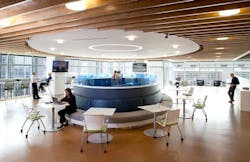6 factors steering workplace design at financial services firms
HOK has released a new benchmarking report that examines design and work-style trends at leading financial services firms over the past three years.
This new HOK Benchmarking Report provides information on recent trends affecting the industry, an analysis of how organizations are using office space, and metrics for space standards based on recently completed workplace projects for financial services firms in New York, Toronto, and London.
Companies are eager to understand the link between their work environments and organizational performance. The space standards and findings in this report can provide a baseline to help corporate real estate and facilities professionals identify and respond to opportunities for improvement.
The findings are derived from more than one million square feet of spatial data gathered from 11 top-tier financial services firms. HOK collected and analyzed nature-of-work surveys and observational study findings from thousands of employees to understand space utilization and how people actually work in their office environments.
One of the report’s key findings is that growth often can be accommodated within existing space, which is consistently underutilized by an average of 48%. When undertaking renovation projects, firms should consider the creation of multi-purpose environments that encourage more efficient, collaborative and innovative use of space.
“To further strengthen our findings, we triangulated our data sources,” said Isilay Civan, HOK research and strategic innovation specialist and a co-author of the report. “We used a mixed methodology for data analysis that provided the ability to compare and crosscheck our findings across self-reported, observed and recorded spatial data.”
Other key findings:
- Though the financial services industry is growing, it’s facing increased competition from non-traditional service providers influenced by rapid changes in the technology sector.
- Meeting space should be appropriately sized and flexible. Top-tier financial services firms devote more than half of their collaboration space to rooms that accommodate seven or more people.
- More than 90% of individually assigned spaces are open office.
- Mobility strategies are common but adoption rates vary. During periods of high occupancy, there are close to two people for every seat or workstation.
- Building efficiency is tight—as is the average area per seat.
The benchmarking report identified these potential areas of improvement for organizations seeking to enhance human capital and productivity:
- Space for focused work
- Overall impression of the workspace
- Tools and technology in the workspace
- Ergonomics
- Space for private calls
- Adaptable/well-laid out workspaces
- Sufficient acoustical separation
“We didn’t want to simply report the data findings without recommending potential next steps and solutions,” said Rob Sannella, a senior HOK strategic consultant and a co-author of the report. “In this report, we have translated our findings into actionable items to inform and enhance design decisions.”

